Nissan Interstar vs. Toyota Proace Max: Which is the Best Large Van?

European brands dominate the commercial vehicle market, but the all-new Nissan Interstar and Toyota Proace Max are here to prove it might be worth looking towards Japan for your next large van.
For all the nation’s ubiquity in the passenger car market with brands like Nissan, Toyota, Honda, Mazda, Subaru and – until recently – Mitsubishi, it is perhaps surprising that only two of these Japanese marques have ever attempted to get a slice of the lucrative commercial vehicle market for themselves on this side of the world.
Indeed, while Toyota has long had a presence in the commercial sector, for decades it relied solely on the HiAce mid-size van, while Nissan has only had the Interstar and Primastar (nee NV400 and NV300) since the turn of the Millennium.
Today, however, both brands present a full-strength commercial line-up with Toyota developing the Proace nameplate – which is affixed to its mid-size offering – to include the Proace City small van and Proace Max large van, not to mention the venerable Hilux pick-up truck.
Nissan now also has the Townstar small van alongside the Primastar medium van and the Interstar large van.
For this match-up, we’re focusing on the biggest vans in the respective line-ups – the Nissan Interstar and the Toyota Proace Max - which just happen to be two of the newest models in the large van sector too.
So, while rivals like the Mercedes-Benz Sprinter, Ford Transit and Volkswagen Crafter enjoy an enduringly strong grip on large van sales in the UK, should their Japanese equivalents be considered as serious alternatives to the European defaults?
European Body, Japanese Soul
While the badging on the front of the Nissan and Toyota is very much Japanese, peel the names away and you’re left with two very European vehicles.
Indeed, it is perhaps no surprise that Nissan and Toyota have utilised their close ties with European marques – in this case Renault and Peugeot/Citroen respectively – to develop their commercial arms.
For Nissan, the association with Renault is hardly a surprise, the two companies having collaborated closely since the formation of its alliance in 1999.
It means the arrival of a new, completely overhauled Renault Master last year has in turn bred a new generation Nissan Interstar being built alongside it in France.
The Toyota Proace Max, meanwhile, shares its underpinnings and an assembly line with the Stellantis Group’s large vans – the Citroen Relay, Peugeot Boxer, FIAT Ducato and Vauxhall Movano.
An extension of an agreement that led to the Stellantis-built Proace mid-size van, the Proace Max therefore gives Toyota a contender at the bigger end of the SCV scale for the first time.

Lease the Nissan Interstar if...
- You like a spacious and ergonomic cab space
- You need a generous payload capacity
- You’re choosing a large electric van
- You’re after a large yet frugal van for an urban-based business

Lease the Toyota Proace Max if...
- You need outright cargo carrying capacity
- You want an industry-leading manufacturer warranty
- You’re considering a tipper, dropside or chassis cab conversion
- You appreciate it being (arguably) the most handsome looking large van
Lease A Nissan or Toyota Van with Vansdirect
Leasing a new Large Van with Vansdirect has never been easier or better value.
Get the right van at the right deal, right now with the best large van leasing deals available across a wide array of models, including the Nissan Interstar and Toyota Proace Max.
Speak to our expert team today and you could be driving a new van for less than you think.
Interstar vs Proace Max: Cargo Load, Dimensions & Practicality
Of the two models, the Toyota Proace Max offers a greater number of body sizes with four configurations versus the Nissan Interstar's three.
Even so, the two models match up for the most part by each offering an L2/H2, L3/H2 and L3/H3 body style.
Where they differ is the Proace Max being available in an even larger L4/H3, though it is worth noting Toyota offers a trimmed line-up compared to its Stellantis siblings, which come with the choice of six body sizes.
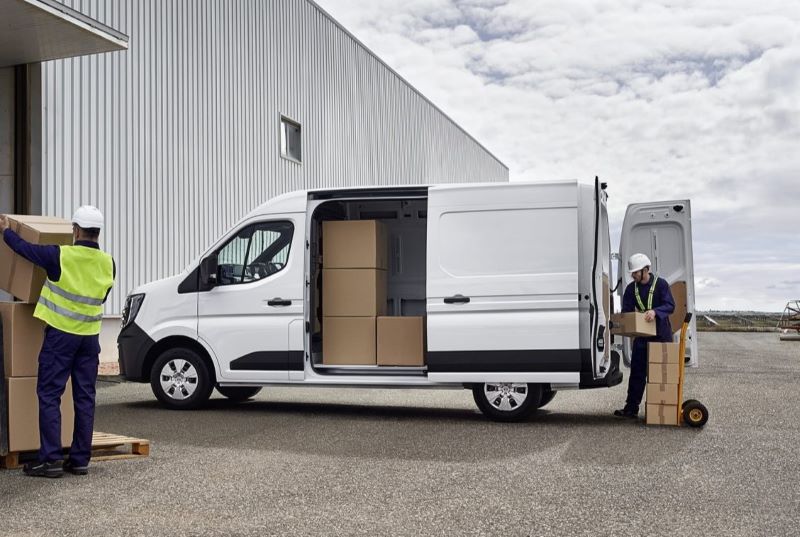
Regardless, the three body sizes both models share do represent the most popular configurations in the large van class.
In terms of outright space, the Proace Max has the measure of the Interstar, despite the Nissan having the longer wheelbase and overall length.
However, while the Interstar has the advantage in length, the Proace Max is notably taller and wider, which adds up to a larger cargo area overall of 11.5 cubic metres for the L2/H2, 13 cubic metres for the L3/H2 and 15 cubic metres for the L3/H3, while the largest L4/H3 goes right up to 17 cubic metres.
By contrast, the Nissan Interstar L2/H2 offers 10.8 cubic metres, the L3/H2 has 13 cubic metres and L3/H3 has 14.8 cubic metres.
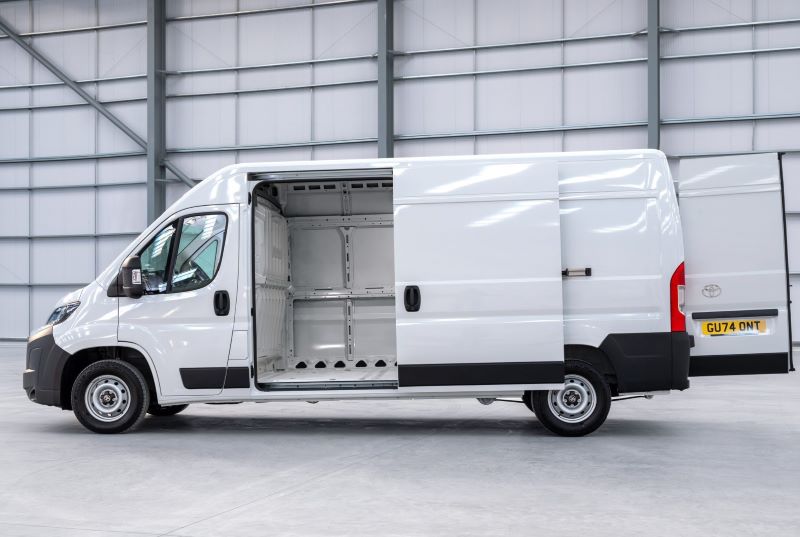
However, while the Interstar’s load bay may be smaller in outright volume, the superior load length at floor level – 3225/3855mm compared to the Toyota’s 3120/3705mm - might prove more useful if you happen to regularly transport particularly long items.
It’s also worth noting that the largest L4 Proace Max has the same wheelbase as the smaller L3 version as the extension is placed behind the rear axle to limit load intrusion from the wheelarch housings.
Both models come with a large array of body conversions too with crew van, dropside, tipper, Luton box and chassis cab variants all available.
Interstar vs Proace Max: Weights, Loads & Towing
In terms of payload, the Nissan Interstar is undoubtedly the large van to choose over the Toyota Proace Max if your business regularly involves transporting heavy cargo.
Indeed, the Interstar benefits from being significantly lighter than the majority of its rivals in the large van class.

This is made possible by Renault – which led engineering work on the Master and Interstar – making significant weight savings during development to ensure the Interstar doesn’t exceed a four-tonne gross vehicle weight, even in electric guise.
As such, the Interstar can devote more weight to payload capacity across all three body sizes.
With a GVW of four tonnes, the diesel-powered L2/H2 is capable of carrying 1934kg, while even 3.5T and 3.3T models can achieve 1447kg and 1247kg. In L3/H2 and L3/H3 guise, the payload range between 3.5T and 4.0T models is 1347 to 1862kg.
By contrast, the Proace Max’s diesel range offers a payload capacity of 1265-1400kg across the L2 and L3 body configurations.
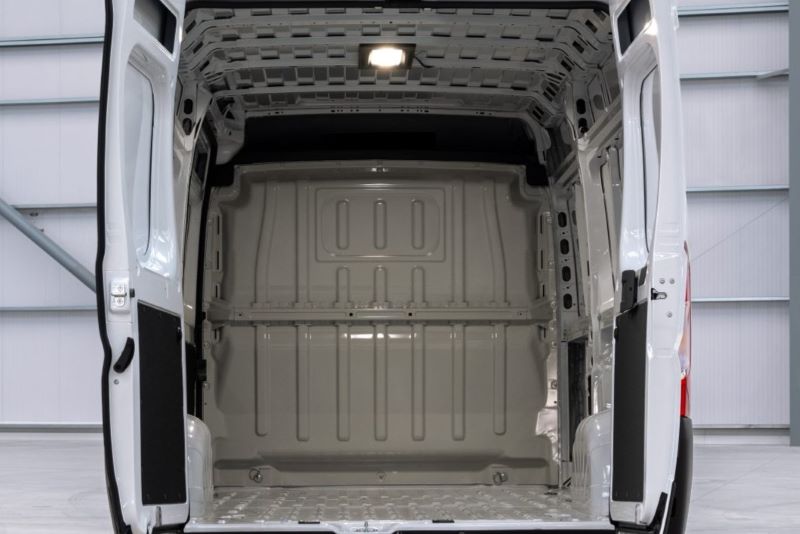
For the Toyota, the largest payload is actually achieved using a battery by virtue of electric being the only powertrain available on the biggest L4 model.
Even so, the L4 Toyota Proace Max Electric payload of 1460kg is exceeded by the Interstar EV’s 1694kg available on the 4.0T L2/H2 model.
The Proace Max is the better large van for towing, however, either in diesel or electric guise with a max braked towing capacity of between 2400 and 3000kg, compared with the Interstar’s 1500 to 2500kg capacity.
Interstar vs Proace Max: Engine, Performance & Running Costs
Under the bonnet, the Nissan Interstar offers up three power variations of its Renault-sourced 2.0-litre turbodiesel engine – generating 130, 150 or 170 PS – while the Toyota Proace Max makes do with just the one, a 140PS 2.2-litre powerplant.
While fuel economy will be dependent on factors like payload, the Interstar is the more frugal model in turbodiesel guise with a combined 42mpg from the 130PS engine, compared with the Proace Max’s 37mpg when mated with the manual gearbox.

If you’re considering electric for your next large van, the Interstar again betters the Proace Max with a class-leading 285 miles of range quoted by the manufacturer versus the Toyota’s 260 miles.
The Interstar’s impressive range comes despite its 87kWh battery being considerably smaller than the 110kWh capacity unit in the Proace Max.
While this physical size differential is reflected in their respective power outputs – 141bhp and 275bhp – Nissan claims the Interstar’s aerodynamic shape and weight-saving gains allow it to choose a smaller battery that ensures extended range without compromising load carrying ability.
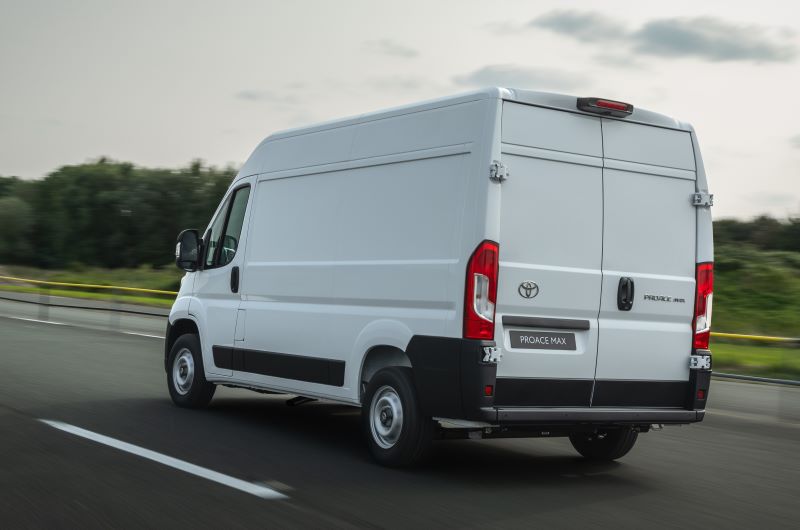
It also means the Interstar is quicker to recharge, going from 0-80 per cent in 37mins using a fast charger, which is considerably quicker than the 55mins it takes to replenish of the Proace Max.
On the move, both models come with Normal and Eco driving mode, the latter restricting the sensitivity of the throttle and some of the interior cooling settings to enable a few extra miles of range. The Proace Max does also have a ‘Sport’ setting which gives it a noticeable spring in its step and is certainly useful when overtaking or tackling inclines.
It is a shame, however, that entry-level 105PS turbodiesel and 40kWh battery electric options were removed from Interstar price lists shortly after launch as they made great value, frugal alternatives in a segment of generally large capacity models.
Interstar vs Proace Max: Cab & Interior
The Nissan Interstar – and by extension the sister Master version – has drawn upon Renault’s experience in the heavy-goods industry (via its Renault Trucks subsidiary) for its smartly-appointed interior.
Indeed, anyone who has happened to sit behind the wheel of an HGV will recognise the wide-set centre console that curves towards the driver to ensure all controls and screens are within a peripheral line of vision.

It’s an approach that also frees up plenty of room for passengers, which each get their own individual chair moulding instead of a flat bench seat.
While recent van launches – including the Proace Max – have adopted a digital approach in interior design, the Interstar’s more restrained approach is both logical and refreshing.
It means you will find analogue dials for revs and speed (diesel only), a physical handbrake by the driver’s seat and a modestly-sized - but well-positioned - infotainment screen that is easy to get your head around. We also applaud Nissan/Renault resisting the temptation to delegate heating controls to fiddly touchscreen punches.
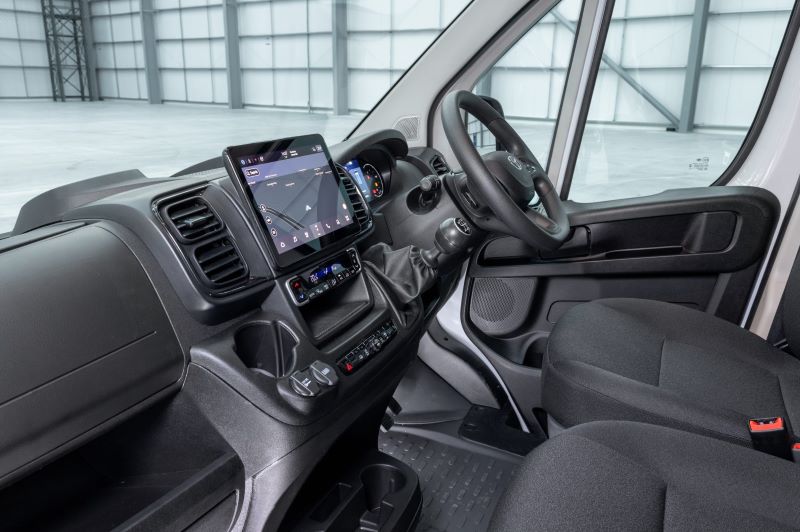
As for the Proace Max, while a recent revision helped to bring the interior more up to date, it is not as ergonomically friendly as the Interstar with none of the Nissan’s angled surfaces making everything feel easy-to-reach. It is solidly built though, while the touchscreen is crisp.
Where the Interstar reigns, however, is the vast amount of interior storage space available. From cubby holes to shelves to under seat stows, the Interstar offers an extra 100-litres of storage in the cabin alone.
Interstar vs Proace Max: Standard Equipment & Features
The Nissan Interstar is offered with the choice of two trim levels – Acenta and Tekna.
Standard kit across the range includes driver/passenger airbag, daytime running lights, front fog lights with cornering function, adjustable seats and armrest, electric windows, heated door mirrors, Bluetooth connectivity, rear parking sensors and air-conditioning.
Upgrade to the Tekna and you’ll also get 16-inch steel wheel covers, 270-degree 50:50 split rear doors, more anchorage fix rings, a heated windscreen, 360-degree parking sensors and a rear-view camera.
The Toyota Proace Max makes do with just the single trim – Icon.
Standard equipment includes a 10-inch multimedia screen, a three-spoke leather steering wheel, dynamic reverse camera lines, cruise control, air-conditioning, electric mirrors, electric windows, push-button start and Bluetooth connectivity.
Interstar vs Proace Max: Reliability
Arguably the most interesting selling points for both the Nissan Interstar and the Toyota Proace Max are their very generous manufacturer warranties.
Indeed, Japanese brands have for decades cultivated a reputation for durability, a commitment that is reflected in Nissan and Toyota’s passenger cars enjoying some of the most reassuring aftersales care packages in the industry.
It’s a confidence that Nissan and Toyota have actively chosen to apply to its commercial vehicle range, despite development of each model being led by Renault and Citroen/Peugeot, respectively.
As such, Nissan has applied its standard five-year warranty to the Interstar, despite the equivalent Renault Master only getting a three-year warranty.
More extraordinarily, the Toyota Proace Max comes with the firm’s industry-leading 10-year/100,000-mile warranty - just as you would find on a Corolla, RAV4 or Yaris – even though its Citroen/Peugeot/FIAT/Vauxhall siblings get a warranty of just three years.
Toyota’s warranty is by far the best aftersales package in the van industry – with Nissan a distant second – and is made possible by the Japanese firm insisting on its own inspection process post-assembly to ensure the Proace Max meets its high standards of quality. The warranty is, however, only valid if you service it every year or every 10,000 miles by an official Toyota dealer.
Interstar vs Proace Max: Safety & Security
Both the Nissan Interstar and Toyota Proace Max are well kitted out in terms of safety features with technology assistance designed specifically to ensure drivers remain alert and secure on the road.
Both models come with features that include Lane Departure Warning, Lane Keeping Assist, Forward Emergency Braking, Driver Drowsiness and Attention Warnings, Intelligent Speed Assist and Hill Start Assist.
The Proace Max adds glass-breaking alarm sensors and blind-spot assist, as well as pre-collision system with pedestrian and cyclist detection.
Both models have been assessed by EuroNCAP, which conducts its rating based on the strength of their safety features and effectiveness in simulated tests. In both instances, the Interstar and Proace Max were awarded five-stars.
Nissan Interstar vs Toyota Proace Max: THE VERDICT
First and foremost, there is a very compelling case to make for choosing either the Japanese-badged Nissan Interstar and Toyota Proace Max if your heart is set on a Renault Master or Vauxhall Movano et al.
There are barely any discernible differences between their respective siblings from a technical perspective with identical dimensions, engines and running gear.
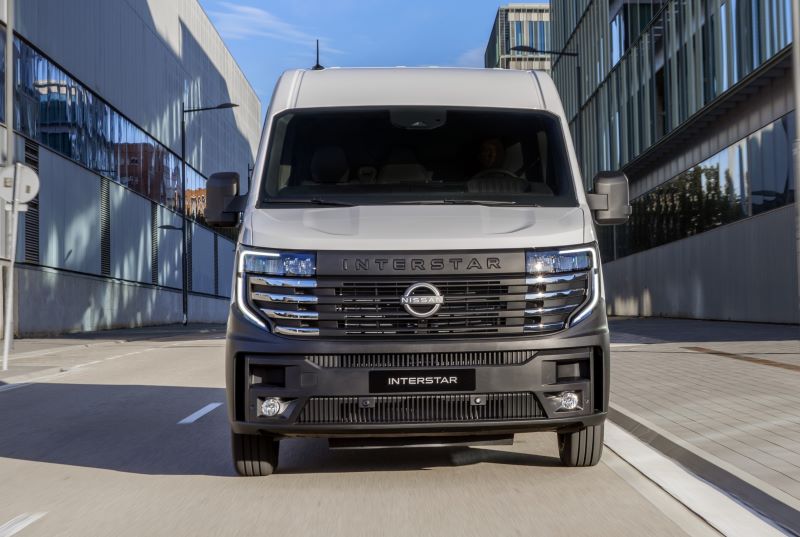
However, both models stride ahead of their counterparts when it comes to aftersales care with Nissan’s five-year warranty and Toyota’s ten-year warranty making Renault, Citroen, Peugeot, FIAT and Vauxhall appear comparatively stingy.
Given such a large disparity when it comes to the manufacturer warranty relative to the precious little there is to otherwise split them from their stablemates, the Interstar and Proace Max therefore emerge as the pick of their family of models.
If it comes down to a choice between the Interstar and Proace Max themselves, the former’s huge payload capacity, modern interior and frugal engine/battery gives it the nod over its rival.
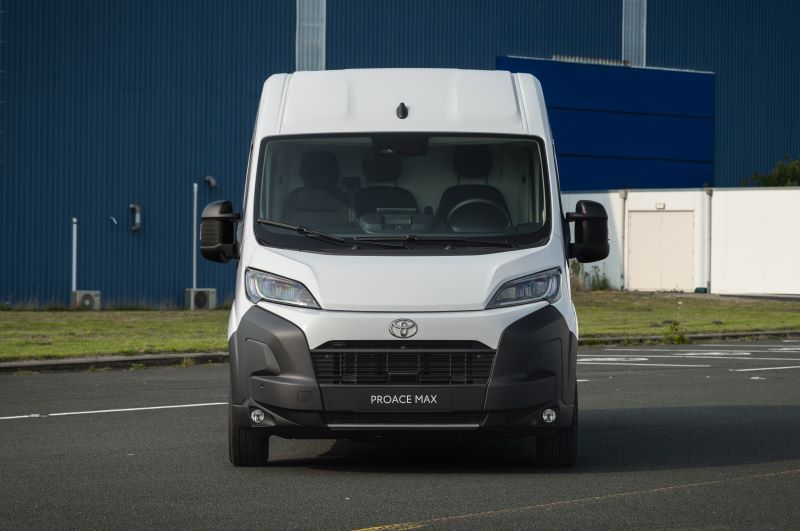
However, if you need outright cargo capacity, more generous kit levels or plan to own it long enough to capitalise on that warranty, the Toyota Proace Max makes a worthy choice too.
















